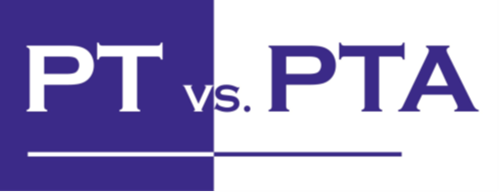Most professionals have assistants, for example, a physician (MD) has a physician assistant (PA). Hence, a physical therapist (PT) has a physical therapist assistant (PTA). Each is incredibly educated requiring a graduate degree from an accredited physical therapist program for PTs, and an associate degree from an accredited PTA program for PTAs, followed by both taking the National Licensure Exam for the Commonwealth of Virginia; PTs (now required to have either a masters or clinical doctorate), and PTAs (who provide services under the direction of a licensed PT). Thus, creating a dynamic duo that has the most specialized education with an established theoretical and scientific base, widespread clinical applications in the restoration, maintenance, and promotion of optimal physical function. But, often it is misunderstood that, like physicians and physician assistants who work together as a team, PTs and PTAs are not considered equals in their profession. So what is the difference you wonder? The only difference is that PTAs cannot perform Initial Evaluations-a collection of patient history, conducting a systems review and the performance of tests and measures to identify potential and existing problems-in short the Diagnosis, Prognoses, Re-Evaluation of the Diagnosis, Plan of Care, or the development and implementation of Discharge plans.
So what is left for the PTAs to do for you? Well, that’s easy! PTAs can carry out the plan of care and goals established for you by your PT.
That’s right! Your PT carries out your treatment through their assistant. This is because Physical Therapy is different than a visit with your Physician. You have more visits because you are now in the treat and be treated phase. Your body is ready to have all anatomy systems relating to your condition treated such as muscle/brain re-education (teaching your brain to use your muscles properly), making sure you are doing your homework, (also called a Home Exercise Program or HEP), and performing Manual Therapy (which is when the PT/PTA physically performs stretches or manipulations to the affected, and surrounding, part(s) of the body.)
Of course, you do see your PT during your treatment, but this teamwork allows for the PTs to evaluate other patients coming in for their first visit, as you continue with your treatment. The saying goes that for everyone visit you have with your PT, you might have the next two visits with their PTA; that’s usually how we conduct our patient’s treatment series at Carousel. Meanwhile, there is constant communication, verbal and documented, between the dynamic duo allowing 2-sets of eyes that can differentiate between any possible hiccups during your treatment, such as strategies or plateaus. This allows for re-examination or modifications necessary to achieve the anticipated goals and expected outcomes to restore optimal quality of life as it relates to movement and health!

